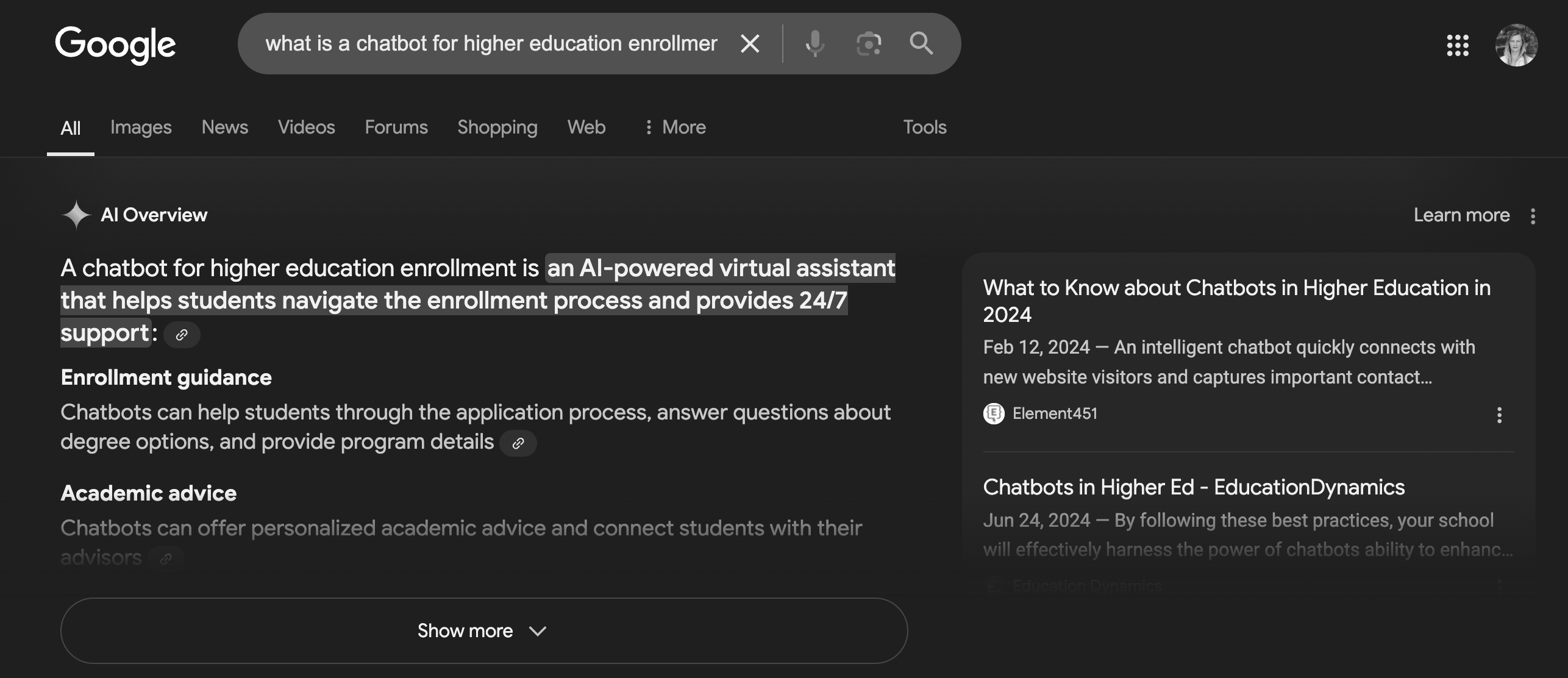A Comprehensive Guide to Digital Marketing for Schools
by Brandon Hurter · Updated Nov 05, 2024

Introduction
Learn about the foundational elements of a comprehensive digital marketing strategy in higher education. This guide focuses on the most important priority areas that your strategy should include—and tips and ideas for each area. We’ll also touch on AI trends in digital student recruitment plans and provide more resources for exploring this new frontier.
Key Digital Marketing Strategies for Schools
Below, we cover the marketing channels that are the most effective for higher education, including websites, SEO, social media, content marketing, influencer marketing, and community outreach. We’ve prioritized this list for you and broken it down into 9 areas. We’ll focus primarily on enrollment marketing and prospective student engagement, but you can expand any of these strategies to engage alumni, parents, donors, industry partners, and other stakeholders.
Priority 1: Build A User-Friendly Website
The cornerstone of a digital marketing strategy for a school is a well-designed website, with a modern user experience (UX). Your website is the single biggest repository of information about your institution and the branding channel you have the most control over. The new generation of students, empowered by digital technology and shaped by consumer culture, have higher expectations for school websites than prior generations. They’re looking for user experiences akin to what they receive from platforms like Amazon or Netflix.
To successfully engage prospective students, your website needs to:
- Function beautifully on mobile devices
- Offer a clean, intuitive navigation that is student-centered
- Make it easy for applicants to complete essential tasks
- Present academic content clearly and thoughtfully
- Serve up event calendars, news feeds, and application forms
Most schools enhance their website every year to keep up with advances in web design and technology. For instance, students increasingly expect to use AI-powered chatbots for common questions and tasks. Artificial intelligence tools can assist prospective students with application management, event registration, and appointment scheduling to reduce the burden on your team for updating content at the speed students demand.

“The new generation of students, empowered by digital technology and shaped by consumer culture, have higher expectations for school websites than prior generations. They’re looking for user experiences akin to what they receive from platforms like Amazon or Netflix.”

Priority 2: Implement Search Engine Optimization (SEO)
The second fundamental element of a higher education digital marketing strategy is a plan for search engine optimization (SEO). A strong SEO plan doesn’t just drive users to your website. It also:
- Increases your brand’s visibility and authority, even when users don’t visit your site
- Provides data and insights on your prospective students’ searches, intentions, and trending interests
- Supports your other marketing efforts, like social media, paid advertising, and public relations
- Keeps you informed about your competitors’ strengths and weaknesses
The components of a basic SEO plan include keyword research, content writing with that keyword research, and paying attention to meta descriptions, titles, and alt text for images. More advanced SEO strategies require more time and resources—but they often have a higher ROI compared to paid advertising and other marketing spends.
AI is rapidly changing the playbook for SEO. The new frontier in SEO strategies for schools will focus on appearing in search engine AI answers, like SearchGPT and Google’s AI Overviews.

Priority 3: Develop A Social Media Marketing Strategy
Social media strategies for higher education begin with selecting the right platforms to focus on. Don’t attempt to cover every platform or publish the exact same content across platforms. First, take the time to audit and understand which platforms your target audiences are using. Your undergraduate prospective students may spend the most time on Tiktok or YouTube, while your graduate school students might be most reachable on LinkedIn and Instagram.
Start developing your school’s social media strategy with these key steps:
- Research your prospective students’ use of social media.
- Decide to concentrate on two to three platforms.
- Create a content calendar to post regularly.
- Be ready to adjust the calendar for unforeseen events.
- Encourage student-generated content, like account takeovers, dorm tours, day-in-the-life reels, etc.
Priority 4: Create A Content Marketing Plan
Once the above priorities are established, you can really start to tell your school’s story through content marketing. The goal of a strong content marketing plan is to attract potential applicants to your website by posting content that is genuinely valuable and interesting to your audience.
While embedding one or two target keywords into your content is important, content marketing only works when it resonates meaningfully with your students. Vanity content can give off a stuffy impression. Instead, try directly addressing the anxieties and aspirations of your prospects. Engaging them emotionally through storytelling is the best way to build trust and connection.
Begin by identifying the questions that are most on your students’ minds. Then, translate those to memorable content. Blogs, articles, newsletters, videos, downloadables, and infographics are all worthwhile vehicles for content marketing. And remember: always include a subscribe button or form to capture leads!
Priority 5: Establish An Email & SMS Marketing Campaign
Once you capture prospective student leads, you need to stay on their minds with an effective email and text marketing campaign. Create segments and messaging by the major stages of the enrollment funnel: inquire, compare, apply, decide, and enroll.
An essential first step is to select and invest in a robust Customer Relationship Management (CRM) software system that is designed for higher education institutions. Your CRM should give you immediate, actionable insight into how much your email and text campaigns are helping you meet your business goals.
While no one-size-fits-all approach or frequency for an email/SMS marketing campaign exists, your school can quickly learn what resonates by analyzing the right engagement metrics. Schools have had impressive success using the Element451 Campaign Builder to build highly personalized campaigns and see engagement data in real time.
Priority 6: Engage With The Local Community
Strengthening ties with your local community can go a long way in building awareness, trust, and word-of-mouth referrals for your school. Digital engagement with communities often combines email campaigns, content marketing, social media, and special sections on your website. Share information and stories about:
- Internships and partnerships with local businesses
- Events and facilities that are open to the public
- Student community service projects
- Profiles of alumni or student families in the area
- Local donors, especially loyal, annual contributors
Priority 7: Manage Online Reviews And Reputation
Anxiety around your school’s rankings and online reviews is normal—and it is important to focus attention on what you can influence most. Set up a pro-active system to monitor reviews and mentions on Google, Niche, The Princeton Review, and social media platforms that allow you to post responses. Then, set aside time and resources to respond promptly to any positive and negative comments. You can also encourage satisfied students and parents to leave reviews.
Priority 8: Host Virtual Events And Webinars
While all admissions teams host virtual information sessions and open houses, your marketing team can augment these efforts with online events that reach broader audiences. Live programs and recorded sessions about student life, community issues, campus culture, and school news can engage people anywhere, in any time zone. Registration can build your email list, and interactive tools like polls and Q&A can help you understand your audience more and build connections.
Priority 9: Collaborate With Influencers And Alumni
Partnering with alumni or renowned influencers can also extend your audience reach and build credibility. The key is to ensure whomever you’re partnering with aligns with your school’s values. Reviewing their online presence carefully before collaborating can help you avoid PR problems. Once vetted, create collaborative content like guest blogs, joint online events, and social media posts on their and your accounts.
Other Benefits of Digital Marketing for Educational Institutions
Increasing enrollment isn’t the only benefit of this multi-pronged approach to digital marketing. A consistent, thoughtful execution will build affinity and trust with your other stakeholders, such as current students, faculty, alumni, parents, donors, and industry partners. Getting your online presence up and running smoothly can also enhance your retention rates, funding base, school reputation, and brand authority.
AI Trends in Digital Marketing for Schools
Leaders in higher education are eager for practical recommendations on integrating AI into their digital marketing strategies. AI marketing solutions have enormous potential to save schools time and expense, while increasing outcomes in almost every area of enrollment and brand management. But the array of offerings and approaches can easily lead to overwhelm or over-hasty adoption.
The major AI trends for schools on the horizon are:
- Leveraging data to personalize email and web content to the individual student
- Using AI editing tools to speed the production of live streaming, video testimonials, and promotional videos
- Protecting student data and ensuring regulatory compliance with enhanced data security safeguards
Our free AI Guide for Higher Ed and AI Readiness Assessment can help your institution create a roadmap for incorporating AI in sustainable, secure, successful ways.
Conclusion
This comprehensive list of strategies will help you cover all bases when competing for student attention in the digital landscape. However, you don’t have to implement every one to achieve your goals. Your team and budget may only allow you to tackle a few priority areas, but “depth over breadth” is what counts.
The key takeaways are:
- Always tailor your strategies to your particular audience’s needs.
- Publish content that builds trust and creates an emotional connection with your audience.
- Be pro-active about reputation management monitoring and responses.
- Experiment and analyze your results frequently to evolve your strategy.
- Don’t wait for the perfect strategy or moment; start now.
Schools and universities are under greater levels of scrutiny in the media than ever, so it is natural for higher education leaders to hesitate when implementing new strategies or testing new marketing channels. However, schools can miss out on valuable market penetration and engagement if they wait too long to jump in. Preparing a sound strategy is crucial, but executing it and measuring it is even more important. When it comes to reaching this generation’s digital natives, imperfect action over inaction is the best strategy of all.
Frequently Asked Questions (FAQs):
Why do schools need digital marketing?
This generation of prospective students expects sophisticated user experiences, similar to Amazon and Netflix. To reach students and other target audiences, schools need a strong digital presence across multiple platforms and channels to achieve brand awareness.
What are some common mistakes schools make in digital marketing?
The common digital marketing mistakes schools make are 1) waiting too long to implement a strategy for fear of doing it incorrectly, and 2) not taking care to tailor content to their specific student audience’s needs, anxieties, and aspirations.
How often should schools update their digital marketing strategies?
Schools should update their digital marketing strategy at least once a year, but the most successful institutions use data analysis throughout the year to make updates and adjustments.

About Element451
Boost enrollment, improve engagement, and support students with an AI workforce built for higher ed. Element451 makes personalization scalable and success repeatable.
Categories
New Blog Posts

The Definitive Guide
AI in Higher Education
Bridge the gap between the latest tech advancements and your institution's success.
Useful Links
Related Articles

Talk With Us
Element451 is the only AI Workforce Platform for higher education. Our friendly experts are here to help you explore how Element451 can improve outcomes for your school.
Get a Demo








